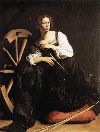The Spiked Wheel
 Tom De Haes wrote The Spiked Wheel for the Royal Concert Band 'De Verenigde Sint-Katarinavrienden' (Sint-Katelijne-Waver, Belgium). The patron saint of the society as well as the municipality is Catharine of Alexandria. The legend surrounding this martyr saint gave the composer the inspiration for this work. In five musical episodes, the last stages of her eventful lif are depicted.
Tom De Haes wrote The Spiked Wheel for the Royal Concert Band 'De Verenigde Sint-Katarinavrienden' (Sint-Katelijne-Waver, Belgium). The patron saint of the society as well as the municipality is Catharine of Alexandria. The legend surrounding this martyr saint gave the composer the inspiration for this work. In five musical episodes, the last stages of her eventful lif are depicted.The course of the story is as follows. The Emperor Maxentius of Alexandria orders his people to hold a sacrificial ceremony in honour of the gods. The people gather for this celebration: there's a lot of drinking, laughing and dancing. Then Catharine appears, a King's daughter famed for her wisdom, beauty and oratorical talent. She convinces everyone present that the gods they worship are just idols, and that there is only one true God. The Emperor, who is distressed by this, sends fifty of his best philosophers to her, who have to dissuade her from her Christian ideas using arguments. However, they do not succeed. On the contrary, Catharine uses her persuasive powers to convert all fifty philosophers to Christianity. The Emperor has them burned alive, and he locks Catharine in a dungeon, where he lets her starve, and has her tortured and flogged. But she refuses to give up her faith. The Emperor Maxentius, who is impressed by her resolve, then has an ultimate and cruel instrument of torture made: a wheel full of spikes and blades. Catharine is taken there, but she is saved by a divine intervention: a stroke of lightning completely destroys the machine. Thousands of fragments are thrown around. At his wits' end, the Emperor decides to have the young maiden beheaded with a sword. According to the legend, there was no blood flowing from her body, but a white, milky liquid. Angels crowned her and accompanied her to Heaven whilst singing praise.
I. The Emperor
The theme of the Emperor is solemn, and begins with the 'devil's interval' (tritone), symbolising idolatry.
II. The sacrificial ceremony
During the ceremony, a cheerful circle dance can be heard, interspersed with short reminiscences of Emperor Maxentius' theme. The gathering of the people, and the fact that the whole community is taking part in the celebration, is echoed in the orchestration: each instrument group is involved in the expression of the theme, and the orchestration gradually becomes richer.
III. Catharine
Catharine's theme is a slow, modest and lyrical melody. Its beginning is taken from the motet 'Ave virginum gemma Santa Catharina' from 'Tria Motetta ex "Libro Secundo" Motettorum IV vocum excerpta, 1539' by Adriaen Willaert.
IV. Dispute, torture, death
The debate is reflected by the continuing alternation between the theme of Maxentius on the one hand, and that of Catharine on the other, both with an increasing tempo and increasingly belligerent in nature. The impending torture on the wheel is announced by the vibraslap and the rattle. The tension is raised, up until the destructive stroke of lightning (Largo dramatico). We then subsequently hear the last command of Emperor Maxentius and the final blow with the sword.
V. Angels accompany Catharine to Heaven
Resignation, compassion and deepening are at centre stage in the last tableau. A new transformation of Catharine's theme - traversed by the Gregorian chant 'In paradisum' - echoes her journey to Heaven.
Publisher
Scherzando Music Publishers, P.O. Box, CH-6332 Hagendorn, Switzerland
Instrumentation
Concert Band - Fanfare Band
Year
Publication Number
Difficulty
Length
2009
1631 - 09 S
15'50"
CD Recording
Concert Band:
Splashes of Gold, The Royal Netherlands Army Band 'Johan Willem Friso', DHR 04-024-3, 2009
Splashes of Gold, The Royal Netherlands Army Band 'Johan Willem Friso', DHR 04-024-3, 2009
copyright - tom de haes - 2017



